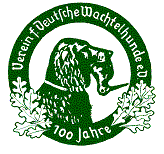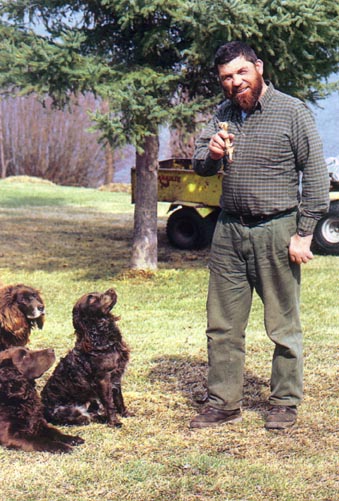The Wachtelhunde
by Bruce Ranta

|
The morning hunt was one of those opening days we all remember.
Only three of the ducks Fritz and I had knocked down had fallen in the open, and these had been quickly retrieved by Ilka and Vallee. The real challenges were the cripples. Fritz and I marked the ducks for Gerhard while he worked the rice in his canoe and the wachtels labored in the thick rice. Using hand signals and German verbal commands, Gerhard systematically had the dogs check each dense clump of weeds and rice until they picked up a hot scent. Two mallards had reached the far shore and had tried to escape into the almost impenetrable pine and balsam forest, but to no avail. it was obvious from watching Gary work the dogs that he was an experienced handler. Even more impressive was the flawless performance of the wachtels. It wasn't long after the hunt when the town vets called my spouse Lillian, whom they knew well due to her involvement with raptor rehabilitation, to excitedly tell her they had finally found a bona fide reference to a wachtel in a British publication on European breeds. Wachtelhundes really did exist! Since then I have found a couple of other writings on wachtels, but the sum of what I have seen written in English is paltry. In English literature, the wachtels are referred to as German spaniels. Gerhard, though, insists they are not a spaniel, despite their appearance, and refused to register the breed with the Canadian Kennel Club when the club insisted they be listed with the spaniel group. According to Gerhard, wachtels, unlike a spaniel, are far-ranging and have been bred to locate and find game where game is scarce. Once they have located game, the dogs give tongue. To give tongue with an open voice is a trait for which they are bred, and if the game is wounded, they must be prepared to run far and long. Given these traits, and the wiry appearance of some wachtels, one might think that if they weren't a spaniel, then perhaps they are a hound. However, wachtels are solo hunters, not pack dogs, searching for and running their own quarry. So in some ways, the wachtel is like a hound, while in others it is much more spaniel-like. Before deciding to bring wachtels to his hunting establishment, Gerhard had tried out both the Labrador and the Chesapeake, but had always found one characteristic or another to be wanting. The Labs he had were top-notch water dogs but were too hyperactive to his liking and were difficult to train to track and deal with wounded bear. He was more fond of his one and only Chessie, which he claimed was a great dog, but it was even more rambunctious than the Labs and was too big to transport in his float plane.
|
|
For more information or to find a Wachtelhund to purchase, visit wachtelhund.com or contact: John Oberhaus joseph9970@fbcom.net 563-210-8273 |

